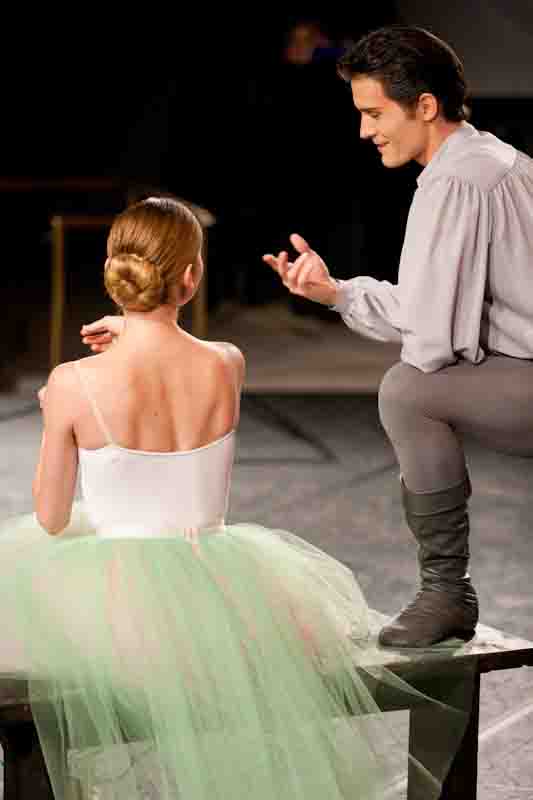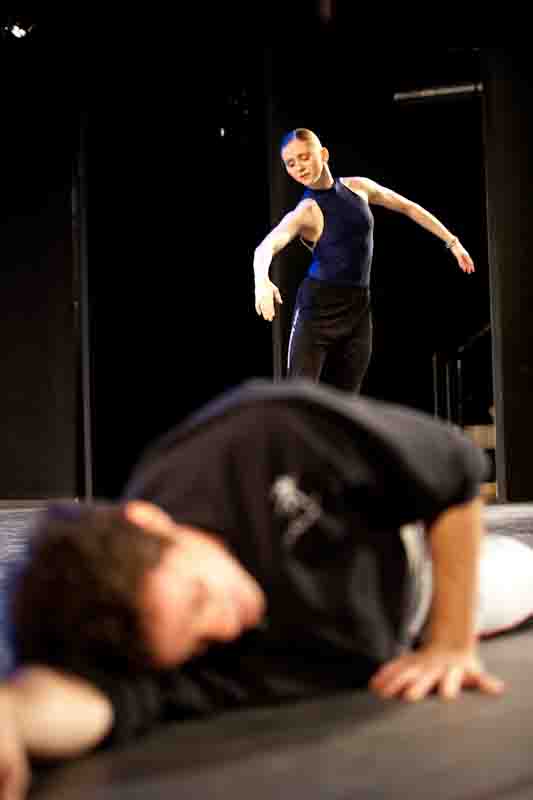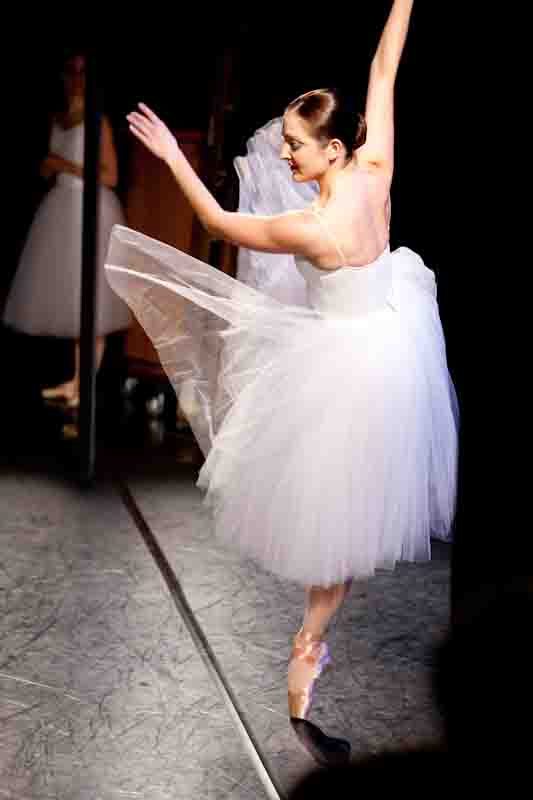Works & Process: Pacific Northwest Ballet: Giselle Revisited / Guggenheim Museum, NYC / January 9 (2 performances) & January 10, 2011
Works & Process, holding forth since 1974 at the Guggenheim Museum on New York’s Upper East Side, has been, at heart, a lecture-demonstration series–Show & Tell for adults attracted by the arts. The programs devoted to dance have traditionally hewed to the simple, sensible pattern of alternating The Talk and The Walk. Spoken explication and anecdote (everybody loves to hear the backstage stuff) about a particular production or person “in the news”–most often, about to be seen in New York–took their turn with members of the company involved dancing excerpts from the coming show on the museum’s bath sheet-sized stage. (The spatial restriction in height as well as width long ago became part of the evenings’ charm.)

Body Language: Carla Körbes and Seth Orza in rehearsal for Pacific Northwest Ballet’s new, scholarship-driven Giselle. Excerpts from the production, along with a detailed discussion of the approach, were featured recently in the Works & Process series at the Guggenheim Museum.
Photo: Jesson Mata
The most recent W&P presentation–“Pacific Northwest Ballet: Giselle Revisited”–concerned itself with the highly respected Seattle company’s new production of the 1841 Romantic classic, which has been based on the investigations of a pair of dance scholars. The far more usual method of mounting a new setting of a nineteenth-century ballet is to have dancers and stagers hand down the traditional choreography as they recall it, consciously or unconsciously emending it, with, on occasion, more radical alterations coming from a choreographer given to new concepts.
In this case the primary work was done in libraries, with the scholars going back to the earliest dance notation scores available and other evidence-on-paper, as I’d call it. Doug Fullington, who had already done some of this back-in-the-day kind of work with PNB, reconstructed the Giselle choreography from documents in the Harvard Theatre Collection that had been notated using a method developed in Russia in the 1890s by Vladimir Stepanov. Although Giselle was created in France, with choreography by Jean Coralli and Jules Perrot, the Giselle we know best today derives from a revision mounted for St. Petersburg’s Mariinsky (aka Kirov) Ballet by the celebrated choreographer and ballet master Marius Petipa. The nineteenth-century Russian classics so revered today were transmitted to the West via Stepanov scores, such as the one for Petipa’s Sleeping Beauty, which Nicholas Sergeyev used to mount the ballet on England’s Vic-Wells (now the Royal) Ballet. “He arrived,” Ninette de Valois, founder of the British company, wrote, “with his tin trunks full of his notation-books . . . which [he] managed to bring out of Russia with him.”
Marian Smith, billed as the Historical Adviser to the production, abetted Fullington’s work by consulting French records from the period of the ballet’s creation and drawing evidence from sources such as Cyril Beaumont’s 1944 in-depth study, The Ballet Called Giselle.
PNB’s Artistic Director, Peter Boal, is credited with the staging of the new production. I assume this means making the intellectual knowledge recently gleaned about Giselle cohere into a theatrically convincing work for a stage on which no words exist.

Near-Death Experience (in rehearsal): Körbes’s Giselle, emerged from the grave, attempts to rescue Orza’s Albrecht, condemned by the Queen of the Wilis
Photo: Jesson Mata
Fullington explained some of the general differences he found between the nineteenth-century Giselle revealed by the written records and the prevailing style in which the ballet is danced today. Virtuosity, he pointed out, means different things in different periods. Nineteenth-century Romantic choreography emphasized swift, light steps (call it fleetness). Today, however, the emphasis is on elevation (the dancer’s ability to surge powerfully through the air at astonishing heights). And then mime, so disrespected nowadays, was formerly cultivated as an indispensable part of dance expression. Gesture was never empty or mechanical; it had to be rendered with thought and heart, so as to express a specific meaning.
Few people can read dance notation of any kind and dance professionals themselves are instinctively wary of it, since their art is deeply visceral and, unlike music, difficult to understand as a set of symbols. However Fullington was almost dangerously persuasive as he described his work–simply because of his contagious enthusiasm for his discoveries, and then for an easygoing charm that avoids any hint of schoolmasterish dryness or patronizing. The final test of his method will come with the public’s response to the finished production. The new-old Giselle will be shown first in Seattle, June 3-12; our appetites having been whetted, it’s a pity we’re not seeing it in New York.
The four dancers present to make the scholars’ theories come alive were quite wonderful in the excerpts of Giselle performed according to the tradition that has evolved until now, and then as it has been affected by the newly implemented evidence of words and signs–with Fullington and Smith gracefully explaining the differences along the way.
Carla Körbes’s dancing (as Giselle) reminded me that the term ballerina is much misunderstood. Too often, among English speakers, it’s taken to mean simply dancer (gender: female). Yes, that’s what it means in Spain, but when you hear it in, say, the intermission buzz at Lincoln Center, it has a far more specific and intense connotation. It designates a female classical dancer who has extraordinary gifts of technique, style, musicality, drama–and compelling (if often subtle) charisma. A ballerina illuminates the entire stage on which she performs.
I always thought Carla Körbes might become a member of that rare breed, from her years with the New York City Ballet–futile in terms of her advancement, though she was a perennial stand-out in the corps and small roles–through Boal’s co-opting her for PNB. This hasn’t happened yet. So many things besides talent combine to shape a dancer’s career: desire, determination, luck, fate. Nevertheless Körbes’s performance at the W&P event made life seem suddenly larger than you’d imagined, more charged with meaning.

The Girl Who Can Do Everything: Carrie Imler, who danced Myrtha, Queen of the Wilis; Berthe, Giselle’s mother; and the Peasant pas de deux in the Works & Process program about Pacific Northwest Ballet’s new Giselle
Photo: Jesson Mata
In the course of the presentation, both Boal and Fullington referred to Carrie Imler as “the girl who can do everything.” They needn’t have bothered; just 60 seconds of her dancing makes that clear. This type of performer–the current prototype is New York City Ballet’s Tyler Peck–is a technical whiz with an outgoing personality, often the backbone of a company. (A lyrical ballerina–think Allegra Kent–is in charge of its soul.) Not haunted by second thoughts, Imler’s type raises the viewers’ spirits and secures their confidence in the show. She was vivid on this occasion in excerpts from three roles that couldn’t be more different: Myrtha, Queen of the Wilis; Berthe, Giselle’s mother; and the Peasant pas de deux.
As Imler’s partner in the pas de deux, James Moore was memorable. He has the comparatively short, robust body of a character dancer but is entirely a danseur-noble type in his dancing, with the purity of execution you’d expect from an artist who had Boal as model and mentor. Moore must have a dramatic imagination too; he made a Hilarion for whom you felt sympathy, despite his rough-hewn aspect and the nasty deeds that come from desperation. His Hilarion loves Giselle with utter sincerity, which, of course, is more than one can say of Albrecht.
Seth Orza, who plays Albrecht, certainly has the anatomy of a prince (albeit in disguise) but something stymies his performance, making him a little stiff, even a little awkward, slightly under-equipped when it comes to energy and personality. But who knows–another occasion might find him all fired up.
Allan Dameron, PNB’s acting music director and conductor, accompanied the dancing with the panache of an extroverted pianist giving a solo concert at Carnegie Hall. His contribution was certainly the opposite of the typical guy–you’ve seen him in the old movies–who played for dance classes in the studios of yesteryear. Undernourished, shabbily dressed, sketchily shaved if at all, with an unfiltered cigarette perennially between his lips, that poor fellow played indifferently on the decrepit piano allotted to him and never looked at the dancers once. Perhaps it’s best that some performances remain modernized.
© 2011 Tobi Tobias




I too was amazed by the pianist. What an artist! He conjured the colors of the orchestra from his instrument and watched the dancers so closely, waiting with bated breath until the dancer’s pointe was about to touch the stage to play the corresponding chord.
From the excerpts we saw, this seems a much more assertive “Giselle.” I loved the extra mime that was shown.
When we saw this lec-dem in Seattle, almost everyone on the artistic staff remarked on how assertive this Giselle is. The materials that Fullington has pulled from the Stepanov notation and that Smith has found in the other documentation present a very assured character.
I don’t know if it was mentioned in the Guggenheim performances, but apparently the mime/pure dance ratio in the original was close to 50/50!
Since for many years I have watched/listened to Allan Dameron conduct the PNB orchestra, and perhaps more significant, accompany rehearsals, I am delighted to learn that New Yorkers have now joined in this pleasure. What was unforgettable was observing rehearsals of Balanchine’s “A Midsummer Night’s Dream” years ago, and because of Dameron’s playing, seeing how precisely the mime in that ballet is musically timed. If this reconstruction of “Giselle” involves, as Sandi Kurtz says, a 50/50 ratio of mime to dance, Dameron has had plenty of practice in wedding the music to the mime. I agree that it’s a pity New Yorkers won’t get to see this “Giselle”; on the other hand, airplanes do fly westward as well as eastward, as I have every reason to know.